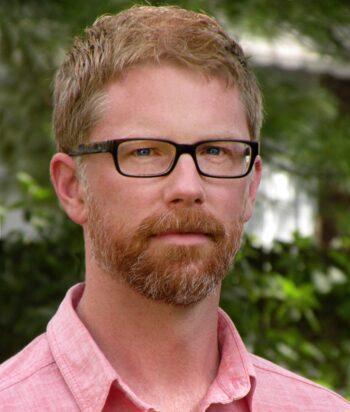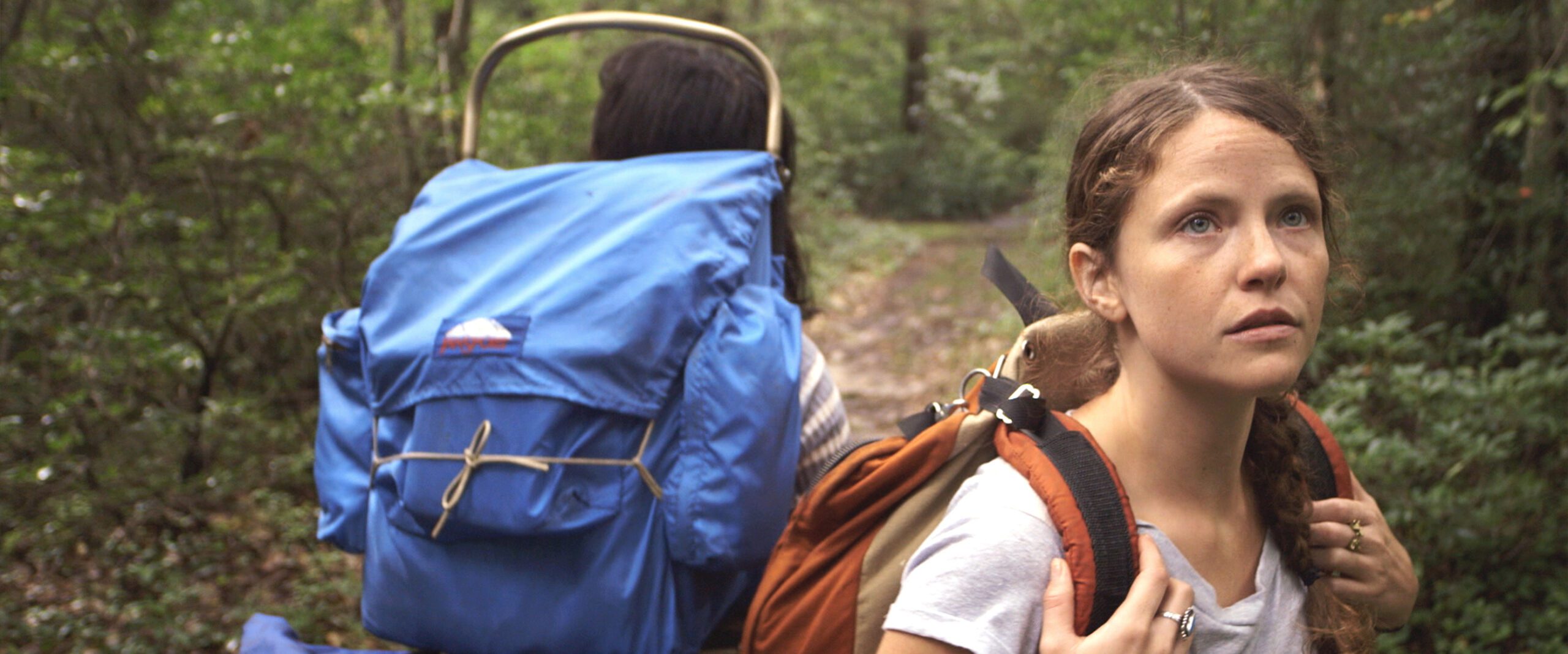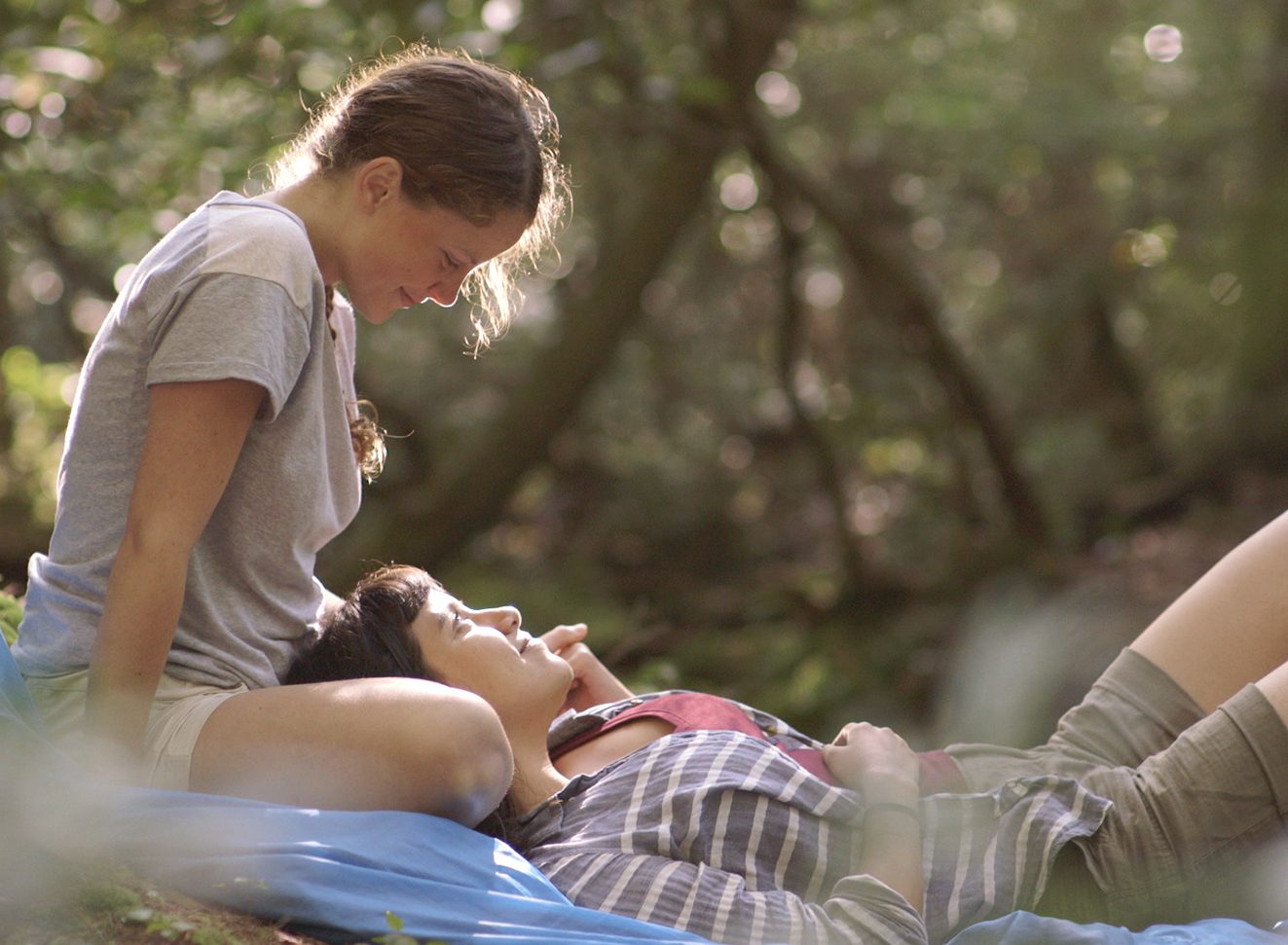
Austin Bunn is the author of the The Brink, a collection of short stories published last month. The collection’s subject matter ranges from a fifteenth-century seafaring vessel that encounters the edge of our flat earth to love letters written by a pining member of the Heaven’s Gate cult. The ten stories are united by Bunn’s hyper-articulate voice that, no matter where it goes, never ceases to entertain. The collection has been longlisted for the Frank O’Connor International Short Story Award.
Bunn is also a filmmaker and his most recent short film, In the Hollow, tells the story of Claudia Brenner, who, along with girlfriend Rebecca Wright, was attacked violently while hiking in Michaux State Forest in Pennsylvania in 1988. The crime and Brenner’s subsequent activism helped lead to The Hate Crimes Statistics Act of 1990, the first-ever law to mention sexual orientation. The film intercuts actors portraying Brenner, Wright, and their assailant, along with footage of Brenner’s return to Michaux State Forest for the first time since the attack.
Bunn’s journalism has appeared in the New York Times Magazine, Wired, and elsewhere. He co-wrote the screenplay to the 2013 feature film Kill Your Darlings, starring Daniel Radcliffe as Allen Ginsberg. He caught up with The Rumpus to chat about his new story collection and latest short film.
***
The Rumpus: No surprise that in a collection called The Brink most of these stories end with characters pushed to some limit or at some bigger beginning. I read elsewhere that you didn’t realize this commonality until you started to arrange the collection. What it is about you that naturally resolves stories in such a way?
Austin Bunn: One of the greatest and most mysterious parts of having a book come into the world is that you have a bunch of people start to see the work in a new way and ask you questions which you don’t necessarily have answers for. I’d say there’s a testimonial tradition at the heart of what short stories are. People come from a powerful experience, and they need to tell. That’s what a story is, to me. And once that event has been told, that’s it, there’s no more dénouement. Novels can explore that long taper, but in short stories I’m very aware that I do not want to overstay my welcome. Leaving while the party is at its peak is sort of my MO.
Rumpus: Even though a lot of these stories have similar types of endings, it certainly wouldn’t be fair to say they all end in similar ways. In “Griefer,” for instance, a story about a man whose life is falling apart as he becomes more and more involved in an online role playing game, we sense the character moving in a much more positive direction at the end of the story. I don’t get that sense with “When You Are the Final Girl,” a story about a teenager who survives a terrible car accident but is horribly burned and decides to mete out a kind of dark justice.
Bunn: As I was writing these stories I found myself thinking about people going through climatic changes in their lives. These pivot points couldn’t all be choices of strength and resilience and power. Some of them had to be choices of fracturing or loneliness or isolation. I was working hard to make sure there was a tonal variation. Writers with range have always impressed me. “When You are the Final Girl” ends in a dark suspension and you feel left at the end of a rope. You wonder what’s going to happen to this girl in this vulnerable moment, and at the same time you’re hoping that this monster you’re spending the whole night with has an emotional need that is deep within the violence. I’m far less interested in violent endings than in revealing some kind of nakedness in which characters have their needs exposed.
Rumpus: Some of these stories might be called concept stories. “Griefer” probably falls into that category. Or “Ledge,” about a group of seafaring men who encounter the actual end of the world. And I’m wondering for how much of the writing process is the concept enough, and when does it have to become about something more.
![TheBrink_PB[1]](https://therumpus.net/wp-content/uploads/2015/06/TheBrink_PB1-680x1024.jpg) Bunn: I’m definitely drawn to premise, and I think that’s because of my film background. I was that kid who liked cool ideas and wondered what it would be like if x, y, or z were to happen. But as I got more mature with my craft I knew that those premises couldn’t be the only thing that would compel someone to read. I think we’ve all had that experience where we think, oh my gosh, what a great idea for a story, but it doesn’t go anywhere. You have to understand a character’s consciousness and perception, or perception shift, and that is what will really push a story through.
Bunn: I’m definitely drawn to premise, and I think that’s because of my film background. I was that kid who liked cool ideas and wondered what it would be like if x, y, or z were to happen. But as I got more mature with my craft I knew that those premises couldn’t be the only thing that would compel someone to read. I think we’ve all had that experience where we think, oh my gosh, what a great idea for a story, but it doesn’t go anywhere. You have to understand a character’s consciousness and perception, or perception shift, and that is what will really push a story through.
I remember the first draft of “Ledge” was really just this busy Poe-like exercise in what would happen if these guys hit the edge of the earth, and it didn’t even have a protagonist, so no story could really transpire. Then I decided to choose one character and focus on what it would mean for him. I started to inhabit this character’s yearning for love and companionship. Friends of mine were joking that that story is one that has so many genres going on at the same time. It’s a seafaring, period, queer, ghost story.
I think a lot of men come into fiction through premise and have to discover interiority. Whereas a lot of women start with character and interiority and have to come to plot. I see that a lot in my screenwriting classes. Male students come to class and want to write about mixed martial arts and alien invasions and everything is external. Women write these really beautiful poetic and lyric relationships, but nothing happens. I try to help them find the middle ground.
Rumpus: Part of premise has to do with constructing a world for your characters to inhabit. The computer game in “Griefer” is a lot like The Sims or Second Life. The boat in “Ledge” is perhaps similar to the Niña, the Pinta, or the Santa Maria. But in “The End of the Age is Upon Us,” the narrator is a member of the actual Heaven’s Gate cult. Is there significance to that story taking place in an actual cult rather than one you invented?
Bunn: Having been a journalist, I have a passion for true stories. If you research enough, they’ll supply so much good information. In “The End of the Age is Upon Us,” I was working at Newsweek, and the cover story was about the Heaven’s Gate deaths in San Diego, and the cover had all these head shots of the people who had died. I remember being really struck by the fact that most of them were in their forties or fifties or sixties or older. But there were two young people, a girl in her twenties and a guy in his twenties. I wondered what would happen if two people fell in love at the very instant they knew their lives were going to end. That piece of research led me down this rabbit hole. All that stuff is still on the Internet. You can listen to (Heaven’s Gate leader) Marshall Applewhite give his final recording, and that’s where that title comes from. “The end of the age is upon us. We are about to be spaced under,” he says. Whatever that means.
I like to travel in fiction. That’s why the stories go back to the fifteenth century, to computer gamers, to Heaven’s Gate. I’m interested in exploring what these subcultures tell us, and what they tell us about the world writ large.
Rumpus: One story maybe you didn’t have to do much traveling for is “How to Win an Unwinnable War.” You’ve said elsewhere that it is the most autobiographical story in the collection. I read in an essay of yours that as a kid you really did take a summer class called “How to Win a Nuclear War.” Tell me a little bit about that.
Bunn: In grad school, I felt like I was seeing a lot my friends write very autobiographical stories and have success with that. I felt a little jealous because my instinct was to write outside my comfort zone about people I didn’t know, worlds I didn’t understand. I had to do all this work to inhabit them. Then I thought, I’ll just write my version of an autobiographical story that takes some license, but not as much as you’d think.
That class was really called Game Theory, but because it happened in 1989 the teacher was really interested in having us learn all this Cold War theory. We got our textbook, and it was a book of payloads and blast perimeters and the types of missiles that countries had in their arsenal. We played a large scale version of Risk. We had allotments of warheads, and the ultimate lesson was that you couldn’t win this game. The story imagines this young man whose parents are in the middle of a separation, and he’s caught in the middle of their cold war. He’s thinking to himself if there is a way to bring his parents together by using the game theory he’s learning. My imagination took off from there—my parents were long divorced by the time I took the class—but the class was real. Some days I’d come home so proud that I had won, or so crushed that I lost. I was a pretty competitive middle schooler.
Rumpus: How did you go from classes on game theory and nuclear war to classes on creative writing?
Bunn: I was in fifth, sixth, seventh grade when the reader came out in me. I think that’s pretty typical to feel around that age that books are solving your problems. My first short stories around this age were all set in post-apocalyptic universes. Your world as a teenager can feel post-apocalyptic, like you’re the only person on the planet who understands what is really going on. The town I grew up in (Madison, NJ) had a really good theater that taught a playwriting program for teenagers. My first play was called Mind Prison: 25,000 AD, about these two men who elected to live in a prison with no walls. Needless to say, it did not get produced. But I got the bug and have been writing since—stories, journalism, plays, screenplays.
Rumpus: You’ve certainly worked in a lot of different mediums. In addition to The Brink, your new short film, In the Hollow, is currently playing the festival circuit. Can you talk a little bit about working in two mediums?
Bunn: Film integrates a lot of things I feel really strongly about, like music and story and performance. Screenplays are really good about displaying the external life. So if you want to tell a story with a lot of action or some beautiful vistas or the sublime, that’s what film is good at. Short stories are the world of the interior domain, of inner experience, psychology, voice, register. It’s changed me as a reader to be a screenwriter. I read a lot of fiction that seems to me like a screenplay in the making because it doesn’t really have an inner life. That’s the kind of fiction I find myself less interested in. But as film has become a bigger part of our culture, novels and short stories are discovering what they do uniquely in this new ecology that has a bunch of other media, which is that inner experience.
Rumpus: You’re not just working in film; you’re working in documentary. Claudia Brenner is a real person. She’s not a character in one of your stories. So if you screw it up the stakes are a lot higher than just having a story draft idling in your hard drive.
Bunn: You’re right. But at least when you’re making a documentary, it’s a much more declarative, objective form. The camera is on a person and that’s how they look: sweaty, tired, surprised, whatever. You’re just showing them. With prose, you’re always interpreting in the act of description.
I watched In the Hollow with Claudia in my apartment, and it was a really powerful experience. The film blends narrative fiction film elements (the story of just two girls camping) and documentary form (Claudia present day, hiking the trail). So she was looking at herself on-screen and looking at an actress play a younger version of herself go through this unspeakable experience. Her first response was that there was too much of her in there, which was not what I was expecting. She’s a very strong person and the film lasers in on moments of vulnerability in her life, these cracks in her armor. She wanted to see and hear herself less, but I think that’s a common response to seeing yourself on screen. Her partner watched the film with her and was supportive and assured Claudia that she didn’t sound strange or look weird. That it was genuinely her on-screen.
Rumpus: In the Hollow is about this horrible attack on Claudia Brenner and her girlfriend Rebecca Wright, but it’s also about hate crime legislation and the first law to mention sexual orientation. In a 15-minute short film there must have been mountains of story that didn’t make it in.
Bunn: With every draft you write of a short story there’s stuff you want to include, but you can’t for length, or stuff to cut because it’s not working. The hike we took with Claudia on the Appalachian Trail was eight hours long, and our cinematographer Spencer Gillis followed her on camera the entire time. How much of that is in the film? About four minutes. Filmmaking is film editing, scrubbing the material to find the lightning. We had several more interviews we did for the film—with an advocate who worked with Claudia, Rebecca’s sister, the sheriff who led the manhunt. Those interviews were great, but had to be trimmed to keep the film around 15 minutes, short enough to be programmed at film festivals.
Rumpus: You not only filmed the real Claudia Brenner, you filmed an entire narrative re-creation of her hike with Rebecca, and their encounters with their assailant leading up to the tragedy.
Bunn: I teach creative writing these days, and one of the values I talk a lot about is topicality and “the now.” I really believe our stories have to connect with contemporary life in order to have meaning. Maybe it’s the journalist inside of me. As powerful as Claudia’s story was, it was set in the past. I had to figure out a way to make it present tense. One way to do that was to make a narrative film of these two girls and what happened to them on this hike. Another present tense thread was to take Claudia back. She’d never been back to where the violence happened since the moment she hiked away, twenty-six years before. And that really brings the film into the present tense in a way that I think is exciting to watch. Because movies are good at that. When you watch a bunch of people talking at the screen it’s not that compelling.
We had Claudia hike the trail first, and then we were able to relocate the narrative of these two girls into the actual locations where these things had happened. In the film we reversed the order, so you see the girls arrive at a place, and then we cut to Claudia arriving there in that same place almost as though it’s been conjured out of thin air. Film editing is actually very similar to short story writing because it’s really the master switch. You get to decide who comes first, what is said, what is off-screen. In that way, I was really at home in editing. I didn’t know how to edit, but I taught myself to cut In the Hollow, because there was no way I could tell someone else how to do it. When I think about editing that film, I also think about all the hours I spent cutting together The Brink, figuring out the order of the stories, which ones to include, which ones not to.
Rumpus: In the age of iPhones, Vine, and Twitter, everyone is shooting video and putting it online. Everyone is a critic and books are often talked about in 140 characters or less. Does this cause you any anxiety as a writer and filmmaker?
Bunn: Now that I’m bringing this book out it seems like “average readers” are increasingly hard to find. It’s almost like we’re a religion that has scattered people, and there’s a massive diaspora of readers out there. It’s not Dickens’s era any more where people are dying to read the latest serial story. But if you value the process of writing, who cares what it’s going to be perceived as in the wider world? The process was the point. That’s why we sit down in a chair in front of a computer to begin with.






